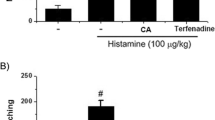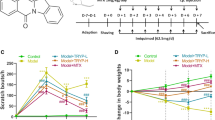Abstract
Anti-oxidant coenzyme Q10 (Co-Q10) is commonly used in clinic. Recently, Co-Q10 was reported to antagonize TNF-α-induced inflammation and play a protective role in various inflammatory conditions. However, its role in dermatitis is unknown. Herein, RAW264.7 macrophage cell line was cultured with stimulation of TNF-α, and administration of Co-Q10 alleviated TNF-α-mediated inflammatory reaction in vitro. Furthermore, oxazolone-induced dermatitis mice model was established, and treatment of Co-Q10 markedly attenuated dermatitis phenotype in this mice model. Moreover, the protective role of Co-Q10 in vitro and in dermatitis was probably due to its repression on NF-κB signaling. Collectively, Co-Q10 may represent a potential molecular target for prevention and treatment of inflammatory skin diseases.





Similar content being viewed by others
References
Zhao, Y.P., Q.Y. Tian, and C.J. Liu. 2013. Progranulin deficiency exaggerates, whereas progranulin-derived Atsttrin attenuates, severity of dermatitis in mice. FEBS Letters 587(12): 1805–1810.
Nakagawa, R., et al. 2011. Pyridone 6, a pan-JAK inhibitor, ameliorates allergic skin inflammation of NC/Nga mice via suppression of Th2 and enhancement of Th17. Journal of Immunology 187(9): 4611–4620.
Kaur, S., et al. 2014. Allergic contact dermatitis is associated with significant oxidative stress. Dermatology Research and Practice 2014: 415638.
Tang, W., et al. 2011. The growth factor progranulin binds to TNF receptors and is therapeutic against inflammatory arthritis in mice. Science 332(6028): 478–484.
Zhao, Y.P., et al. 2014. Progranulin protects against osteoarthritis through interacting with TNF-alpha and beta-Catenin signalling. Annals of the Rheumatic Diseases. doi:10.1136/annrheumdis-2014-205779.
Farsi, F, et al. 2015. Functions of Coenzyme Q10 supplementation on liver enzymes, markers of systemic inflammation, and adipokines in patients affected by nonalcoholic fatty liver disease: a double-blind, placebo-controlled, randomized clinical trial. Journal of the American College of Nutrition : p. 1–8.
Rahmani, A., et al. 2015. Coenzyme Q10 in combination with triple therapy regimens ameliorates oxidative stress and lipid peroxidation in chronic gastritis associated with H. pylori infection. Journal of Clinical Pharmacology 55(8): 842–847.
Jhun, J., et al. 2015. Coenzyme Q10 suppresses Th17 cells and osteoclast differentiation and ameliorates experimental autoimmune arthritis mice. Immunology Letters 166(2): 92–102.
Tawfik, M.K. 2015. Combination of coenzyme Q10 with methotrexate suppresses Freund’s complete adjuvant-induced synovial inflammation with reduced hepatotoxicity in rats: effect on oxidative stress and inflammation. International Immunopharmacology 24(1): 80–87.
Lee, J., et al. 2013. Coenzyme Q10 ameliorates pain and cartilage degradation in a rat model of osteoarthritis by regulating nitric oxide and inflammatory cytokines. PloS One 8(7): e69362.
Grinberg-Bleyer, Y., et al. 2015. Cutting edge: NF-kappaB p65 and c-Rel control epidermal development and immune homeostasis in the skin. Journal of Immunology 194(6): 2472–2476.
Meisgen, F., et al. 2014. MiR-146a negatively regulates TLR2-induced inflammatory responses in keratinocytes. Journal of Investigative Dermatology 134(7): 1931–1940.
Zhang, Y.P., et al. 2013. Diabetic neuropathic pain development in type 2 diabetic mouse model and the prophylactic and therapeutic effects of coenzyme Q10. Neurobiology of Disease 58: 169–178.
Novoselova, E.G., et al. 2009. Naturally occurring antioxidant nutrients reduce inflammatory response in mice. European Journal of Pharmacology 615(1–3): 234–240.
Malissen, B., S. Tamoutounour, and S. Henri. 2014. The origins and functions of dendritic cells and macrophages in the skin. Nature Reviews Immunology 14(6): 417–428.
Orita, K., et al. 2011. Inducible nitric oxide synthase (iNOS) and alpha-melanocyte-stimulating hormones of iNOS origin play important roles in the allergic reactions of atopic dermatitis in mice. Experimental Dermatology 20(11): 911–914.
Wang, Y., et al. 2015. Inhibitory/suppressive oligodeoxynucleotide nanocapsules as simple oral delivery devices for preventing atopic dermatitis in mice. Molecular Therapy 23(2): 297–309.
Schmelzer, C., et al. 2009. In vitro effects of the reduced form of coenzyme Q(10) on secretion levels of TNF-alpha and Chemokines in response to LPS in the human monocytic cell line THP-1. Journal of Clinical Biochemistry and Nutrition 44(1): 62–66.
Weber, F.C., et al. 2015. Neutrophils are required for both the sensitization and elicitation phase of contact hypersensitivity. Journal of Experimental Medicine 212(1): 15–22.
Li, W., et al. 2015. Rebamipide suppresses TNF-alpha mediated inflammation in vitro and attenuates the severity of dermatitis in mice. FEBS Journal 282(12): 2317–2326.
Haitz, K.A., and N. Anandasabapathy. 2015. Docosahexaenoic acid alleviates atopic dermatitis in mice by generating T regulatory cells and m2 macrophages. Journal of Investigative Dermatology 135(6): 1472–1474.
Ha, H., et al. 2015. Luffa cylindrica suppresses development of Dermatophagoides farinae-induced atopic dermatitis-like skin lesions in Nc/Nga mice. Pharmaceutical Biology 53(4): 555–562.
Reisman, S.A., et al. 2014. Topical application of the synthetic triterpenoid RTA 408 protects mice from radiation-induced dermatitis. Radiation Research 181(5): 512–520.
Sivaranjani, N., S.V. Rao, and G. Rajeev. 2013. Role of reactive oxygen species and antioxidants in atopic dermatitis. Journal of Clinical and Diagnostic Research 7(12): 2683–2685.
Narbutt, J., et al. 2007. Repeated low-dose ultraviolet (UV) B exposures of humans induce limited photoprotection against the immune effects of erythemal UVB radiation. British Journal of Dermatology 156(3): 539–547.
Chong, S.Z., et al. 2014. CD8 T cells regulate allergic contact dermatitis by modulating CCR2-dependent TNF/iNOS-expressing Ly6C+ CD11b+ monocytic cells. Journal of Investigative Dermatology 134(3): 666–676.
Lv, J., et al. 2015. Leukotriene B—leukotriene B receptor axis promotes oxazolone-induced contact dermatitis by directing skin homing of neutrophils and CD8+ T cells. Immunology. doi:10.1111/imm.12478.
Yu, M., et al. 2015. Conditional PDK1 ablation promotes epidermal and T cell-mediated dysfunctions leading to inflammatory skin disease. Journal of Investigative Dermatology. doi:10.1038/jid.2015.232.
Aoki, R., et al. 2013. Mast cells play a key role in host defense against herpes simplex virus infection through TNF-alpha and IL-6 production. Journal of Investigative Dermatology 133(9): 2170–2179.
Sugita, K., et al. 2010. Inducible nitric oxide synthase downmodulates contact hypersensitivity by suppressing dendritic cell migration and survival. Journal of Investigative Dermatology 130(2): 464–471.
Choi, J.H., et al. 2013. Cultivated ginseng inhibits 2,4-dinitrochlorobenzene-induced atopic dermatitis-like skin lesions in NC/Nga mice and TNF-alpha/IFN-gamma-induced TARC activation in HaCaT cells. Food and Chemical Toxicology 56: 195–203.
Jia, Q., et al. 2012. Cytokine expression in trichloroethylene-induced hypersensitivity dermatitis: an in vivo and in vitro study. Toxicology Letters 215(1): 31–39.
Fouad, A.A., A.S. Al-Mulhim, and I. Jresat. 2013. Therapeutic effect of coenzyme Q10 against experimentally-induced hepatocellular carcinoma in rats. Environmental Toxicology and Pharmacology 35(1): 100–108.
Acknowledgments
This research was supported partly by the Natural Science Foundation of Shandong Province (ZR2011CM022 to Ruifeng Li), Foundation of Shandong Province Outstanding Young Scientist Research Award (BS2014YY048 to Yunpeng Zhao), and a scientific research grant from Qilu Hospital of Shandong University (26010175616073 to Yunpeng Zhao).
Authors’ Contributions
Yunpeng Zhao and Weiwei Li are responsible for the study concept and design. Yunpeng Zhao, Weiwei Li, Xiaojuan Wu, Min Yang, and Ke Liang are responsible for the acquisition of data. Weiwei Li, Ruifeng Li, Wenhan Wang, Sijia Song, Linlin Guo, Ke Liang, and Xiangling Xu are responsible for the analysis and interpretation of data. Weiwei Li, Yunpeng Zhao, and Sijia Song are responsible for the statistical analysis. Weiwei Li, Yunpeng Zhao, Ruifeng Li, Wenhan Wang, and Xiaojuan Wu are responsible for the drafting of the manuscript.
Conflict of Interest
The authors declare that they do not have competing interests.
Author information
Authors and Affiliations
Corresponding authors
Additional information
Weiwei Li and Xiaojuan Wu contributed equally to this work.
Rights and permissions
About this article
Cite this article
Li, W., Wu, X., Xu, X. et al. Coenzyme Q10 Suppresses TNF-α-Induced Inflammatory Reaction In Vitro and Attenuates Severity of Dermatitis in Mice. Inflammation 39, 281–289 (2016). https://doi.org/10.1007/s10753-015-0248-4
Published:
Issue Date:
DOI: https://doi.org/10.1007/s10753-015-0248-4




